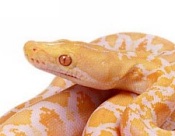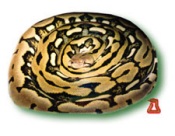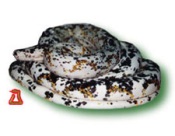reptilediscovery.com
The Reticulated Python
The reticulated python gets its name from the distinctive color and pattern on its scales. According to Webster’s Third New International Dictionary the word “reticulated” is an adjective defined as “having lines intercrossed, forming a network.” It is also known as the regal python (regal is a word that refers to a king). Its scientific name is Python reticulatus.
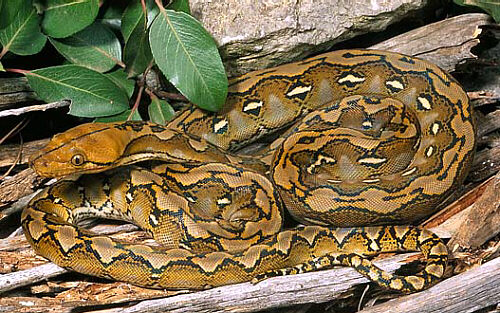
Wild reticulated python photographed on Halmahera Island in Indonesia by David Barker © VPI
This snake is the largest species of python living today. Some people believe that the giant South American water boa, known as the anaconda may grow larger or heavier, but the longest snakes that are found in the wild or that are living in a zoo today are reticulated pythons.
Reticulated python hatch from eggs. Very large females may lay over 100 eggs at a time. The eggs are white and have a soft, leathery shell. Female pythons wrap their powerful bodies around their eggs until they are ready to hatch. This behavior is known as brooding and it prevents the eggs from getting too warm or too cool. The eggs need to remain close to 89 degrees Fahrenheit during the incubation period, which lasts about eighty-five days. The young pythons emerge by cutting a slit in the eggshell with their egg tooth.
Once free from the egg, they are on their own. They must use their coloration and reticulated pattern to hide from predators and to hunt for food. Some of the hatchling pythons get eaten by other animals such as hawks, wild pigs, cobras and monitor lizards. The hatchling pythons are 26 to 35 inches long and weigh only 4 to 5 ounces. From the time they hatch these snakes are also predators and they can kill and eat small mice, rats, lizards and frogs.
Like all snakes, pythons have sharp teeth that are curved towards the back of their mouth. They use their 100 teeth to capture their prey by biting. Their curved teeth hold onto their prey and they kill the animals they catch by wrapping around them and squeezing. The animal is quickly unable to breath and its heart may be unable to pump blood. Pythons can kill their prey in minutes and they swallow their food whole. The entire animal is digested in the snake’s stomach except for fur or feathers, which are passed with the snakes waste.
Reticulated pythons live in tropical forests on the continent of Asia. Their range extends from Myanmar and India, across Southeast Asia and on many of the islands of the Philippines and Indonesia. They are at home on the ground, in caves or in trees and they have adapted to living in towns and cities where they hunt chickens, ducks, rats and domestic cats, dogs and pigs. Large reticulated pythons have eaten monkeys, wild boar, deer and even people. There are not many cases of these pythons capturing and eating people, but it has been reported even in recent years.

Habitat of the reticulated python on Halmahera Island in Indonesia. Photograph by David Barker © VPI
Many species of snakes are hunted by people for their meat and skins, especially the reticulated python. Their large size and the distinctive pattern on their scales make their skins very popular for leather products. Their skins are made into belts, wallets, vests and boots. In the United States many western style cowboy boots are made from Reticulated python skins. Paul Hogan wore a vest made of Reticulated python skins in the movie “Crocodile Dundee” and in the animated movie “Shrek”, a row of hanging Reticulated pythons skins were used by the ogre as a room divider.
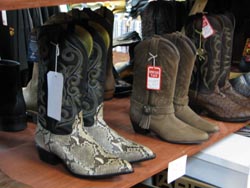
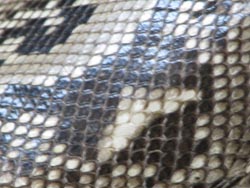
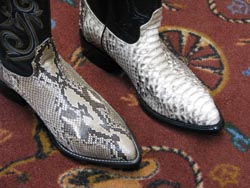
Photographs by Bruce Shwedick©2009 Reptile Discovery Programs
Live pythons are captured in the wild and shipped to other countries where they are sold as pets or to reptile exhibits and zoos. Some very large reticulated pythons are still purchased by zoos, and some are donated to zoos by pet owners when their snakes grow to large for them to keep. Hatchling pythons are popular for some people to keep as pets or as a hobby, but they grow large. They can inflict serious bites with their long sharp teeth and some people have been killed by the very large pythons that they have raised.
Wild Giants
The largest reticulated python ever found in the wild was reported in 1912 from the island of Celebes (now known as Sulawesi) in Indonesia. This snake measured thirty-three feet.
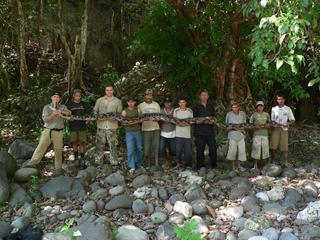
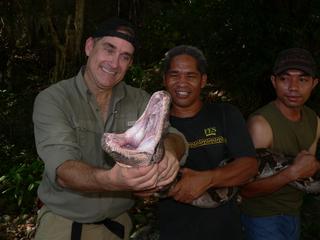
National Geographic Television's reptile expert, Dr. Brady Barr and his field team, capture a very large reticulated python in Indonesia".
Photo ©Brady Barr National Geographic Television
Captive Giants
Very large reticulated pythons have often been kept in zoological parks around the world. Many of them refused food for long periods of time and it was common practice for zookeepers to assist or force-feed them. One specimen at the Frankfurt Zoo refused food for 679 days. Another specimen at the Frankfurt Zoo in Germany measuring 24 feet ate a pig that weighed 120 pounds.
The largest snake that ever lived in a zoo was a reticulated python named Colossus. She lived at the Pittsburgh Zoo in Pennsylvania. You can find her photograph in a book entitled “The Giant Snakes” by Clifford H. Pope. The author of this classic reptile book reported that she was 22 feet long when captured in Siam (now Thailand) in 1949. Eight years later she reached the length of 28 ½ feet long. Her girth measured 37 ½ inches and her weight was estimated to be more than 320 pounds.
The largest reticulated python kept in England was “Cassius”. He was sent to the Knaresborough Zoo in Yorkshire in 1972 after being captured in Malaysia. In 1978 he measured 27 ½ feet and weighed 240 pounds.
A reticulated python from Sumatra named “Gina” was raised from a hatchling at the Bali Reptile Park. According the park’s director, she reached the length of 26 feet four inches in only nine years.
Clash of the Titans
In 2002, the largest reticulated pythons that we know of live in zoos in the United States. Which one is biggest? You decide!
Samantha
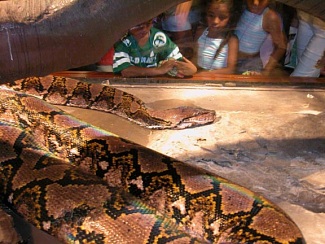
Photograph courtesy of William Holmstrom © WCS/Bronx Zoo
In March 1993, Samantha arrived at the Wildlife Conservation Park/Bronx Zoo from the island of Borneo. She measured 21 feet three inches and weighed 155 pounds. By October 2001, her length increased to 26 feet and she has reached a weight of 275 ½ pounds. During this eight and a half year period she has eaten 63 pigs weighing a total of 1,912 pounds.
Marcy
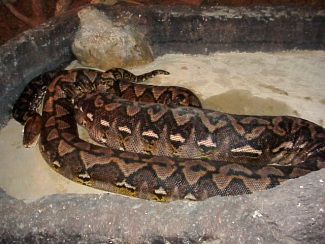
Photograph courtesy of Al Kardon © San Antonio Zoo
Marcy was brought to the United States from the Indonesian island of Sulawesi in 1990. She was raised by Dave and Tracy Barker. The Barkers are both herpetologists, scientists that study reptiles and amphibians. Marcy grew to be 12 feet long by the time she was a year old. By 1994 Marcy had reached a length of nineteen feet and weighed 150 pounds. The Barkers sent her to the San Antonio Zoo in Texas. She is now over 25 feet long and her weight is estimated to be somewhere between 225 and 275 pounds. She is fed one pig weighing between 20 and 50 pounds every two or three months.
Fluffy
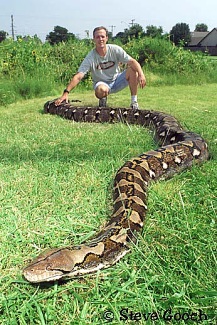
Photograph courtesy of Bob Clark © 2002
Fluffy is one of the largest reticulated pythons held in captivity that is not living in a zoo. She was raised by Bob Clark. Bob Clark is a herpetologist from Oklahoma that works in the field of herpetoculture. Herpetoculture is the raising and breeding of reptiles and amphibians. Fluffy was born in captivity and is thirteen years old. She has reached a length of 24 feet and a weight of 310 pounds.
Unusual Reticulated Pythons
